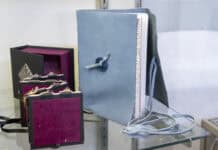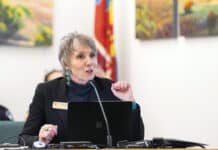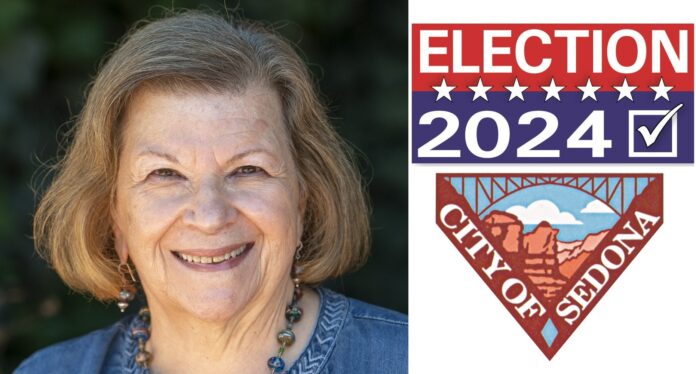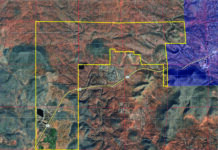Age: 76
Time in Sedona: “I have lived in Sedona for 11 years.”
Background: “I am vice mayor of Sedona. I am a retired attorney, working in the corporate world for over 30 years. For most of that time, I worked side by side with governments at every level: Local, state, federal, tribal and international. More broadly, I focused on helping clients use technology to better serve their constituents. Implementing change in a bureaucracy requires community engagement and collaboration. This is an area where I have learned valuable lessons, used daily.
“As a community leader, establishing strong alliances with partners is one of my guiding principles and is critical in effectively representing our city.
“On the personal side, I am passionate about arts and culture and appreciate that creative energy is a hallmark of Sedona. I am an avid reader, traveler, mentor, organizer and swimmer. I am an advocate of staying healthy and am committed to achieving a sustainable community.”
Q: How do you propose to amend, alter or repeal Sedona’s building codes to help solve the housing shortage?
A: “Building codes exist to protect public health and safety. I have been a constant voice on council to undergo a thorough review of the codes, ordinances and policies that may conflict with affordable housing goals. In fact, on June 12, council conducted a work session to discuss potential changes to the Land Development Code and Development Incentives and Guidelines for Affordable Housing.
“Several code sections were identified by staff for revision including height requirements, kitchens in guest houses, garage spaces, building massing, facades and roofline variations and use of building materials. Exceptions to code requirements in projects that incorporate affordable housing are available. Is it enough?
“Recently-passed legislation will allow cities to require property owners wishing to build accessory dwelling units to live on the property if intended for use as a short-term rental. A similar ordinance has been adopted by other municipalities and is worthy of consideration.”
Q: Council has committed to the future use of the Sedona Cultural Park being decided by the public. What is your view on how that process should be conducted? Do you support or oppose the restoration of the amphitheater?
A: “Council is about to embark on a public planning process to decide the future land use of the Western Gateway, known as Cultural Park. We bought this land for its potential development for housing and other compatible uses. I look forward to the public’s input on how to meet the community’s vision for both workforce and market rate housing, rental and home ownership opportunities as well as other needs. At the same time, we cannot ignore the 200-acre city-owned property — known as the Dells — across from the wastewater treatment plant, which will inevitably be developed.
“How will the public be engaged? The city is hiring a consultant firm to guide us through the process like the Community Plan we recently completed. I expect we will use similar tools conducting open houses, surveys, interactive sessions and other forms of outreach. It is imperative to me that our community support the process, get involved and come together on the outcomes of this effort, whatever it takes. And wherever it takes us.
“Are housing and an amphitheater mutually exclusive? My neighborhood is closest to the Western Gateway. I asked my neighbors living there during the Cultural Park days about their experiences. The feedback was more negative than positive. Noise and traffic were the most common complaints. One neighbor considered hearing the music from his home a benefit. Residents have pointed out neither Barbara’s Park [Barbara Antonsen Memorial Park] nor the Sedona Performing Arts Center existed at the time and question if another venue can be financially supported. [Organizers] just announced the closing of Phillip England Center for Performing Arts [Foundation nonprofit in Camp Verde] for lack of attendance. I’d like to see a business plan from the Cultural Park 2.0 organization addressing these concerns.”
Q: Council has said short-term rentals are an obstacle to affordable housing in Sedona. What can council do to reduce STRs? What can council bring the median home price down to where it’s affordable for median-income residents?
A: “Unless and until we have a more ‘city-friendly’ state legislature, there is little more we can do to regulate short-term rentals. We need a way to cap the number of vacation properties like Utah and Colorado tourist destinations have done. Eleven bills were introduced this legislative session including several which would have allowed reductions. Not one was heard in committee. Only new leadership, with open minds, can change the course.”
Q: How do you suggest the city act to increase home ownership among workers?
A: “Programs such as increasing down payment financial assistance, zoning reform, partnering with developers on city owned land and streamlining the permitting process are actions the city can take to address home ownership and home rental opportunities for local workers. I am very open to meeting with builders, architects and developers who might give specific examples of code or permitting changes they think would be helpful.”
Editor’s Note:
There are three open seats on Sedona City Council in the 2024 election. Incumbent Sedona City Councilwoman Kathy Kinsella, challenger Derek Pfaff, incumbent Sedona Vice Mayor Holli Ploog and challenger Katherine Todd are the four candidates campaigning for three seats. Election day is Tuesday, July 30.




















